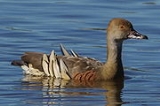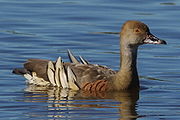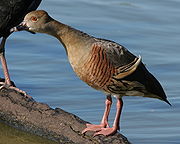
Plumed Whistling Duck
Encyclopedia
The Plumed Whistling Duck (Dendrocygna eytoni), also called the Grass Whistle Duck , is a whistling duck which breeds in New Guinea
and Australia
. It is a predominantly brown-coloured duck with a long neck and characteristic plumes
arising from its flanks. The sexes are similar in appearance.

in 1838, its specific epithet honours its namer. Its generic name is derived from the Ancient Greek
terms dendron "tree", and kuknos (via Latin
cygnus) "swan". Alternate common names include; Eyton's Plumed, Red-legged or Whistling Tree-duck, and Grey or Red-legged Whistler
, it is a long-necked duck with brown upperparts, paler underparts and a white rump. The chest is chestnut with thin black bars, while long black-margined plumes arise from its flanks. Its bill and legs are pink, and its iris is yellow. The male and female are similar in appearance. The species has a characteristic lowered neck and short, dark, rounded wings while flying.
The call is a characteristic whistle which gives the bird its common name.


and Cape York
, down to southern Queensland
and northern New South Wales
on the east coast, although may reach northwestern Victoria
inland, in the vicinity of the Murray River
. It is also found in New Guinea. The preferred habitat is tall grassland and savanna
, often near bodies of water.
for food in bodies of water like other ducks, the Plumed Whistling Duck feeds by cropping grass on land.
are laid, measuring 48 x 36 mm; 14 or more have been recorded on occasion. Initially shiny and creamy-coloured, they may become stained. The incubation
period is around 30 days.
New Guinea
New Guinea is the world's second largest island, after Greenland, covering a land area of 786,000 km2. Located in the southwest Pacific Ocean, it lies geographically to the east of the Malay Archipelago, with which it is sometimes included as part of a greater Indo-Australian Archipelago...
and Australia
Australia
Australia , officially the Commonwealth of Australia, is a country in the Southern Hemisphere comprising the mainland of the Australian continent, the island of Tasmania, and numerous smaller islands in the Indian and Pacific Oceans. It is the world's sixth-largest country by total area...
. It is a predominantly brown-coloured duck with a long neck and characteristic plumes
Plumage
Plumage refers both to the layer of feathers that cover a bird and the pattern, colour, and arrangement of those feathers. The pattern and colours of plumage vary between species and subspecies and can also vary between different age classes, sexes, and season. Within species there can also be a...
arising from its flanks. The sexes are similar in appearance.

Taxonomy
Described by English naturalist Thomas Campbell EytonThomas Campbell Eyton
Thomas Campbell Eyton JP, DL was an English naturalist whose fields were cattle, fishes and birds. He was a friend and correspondent of Charles Darwin though he opposed his theories....
in 1838, its specific epithet honours its namer. Its generic name is derived from the Ancient Greek
Ancient Greek
Ancient Greek is the stage of the Greek language in the periods spanning the times c. 9th–6th centuries BC, , c. 5th–4th centuries BC , and the c. 3rd century BC – 6th century AD of ancient Greece and the ancient world; being predated in the 2nd millennium BC by Mycenaean Greek...
terms dendron "tree", and kuknos (via Latin
Latin
Latin is an Italic language originally spoken in Latium and Ancient Rome. It, along with most European languages, is a descendant of the ancient Proto-Indo-European language. Although it is considered a dead language, a number of scholars and members of the Christian clergy speak it fluently, and...
cygnus) "swan". Alternate common names include; Eyton's Plumed, Red-legged or Whistling Tree-duck, and Grey or Red-legged Whistler
Description
Measuring 42–60 cm (16.5–24 in) and weighing around a kilogramKilogram
The kilogram or kilogramme , also known as the kilo, is the base unit of mass in the International System of Units and is defined as being equal to the mass of the International Prototype Kilogram , which is almost exactly equal to the mass of one liter of water...
, it is a long-necked duck with brown upperparts, paler underparts and a white rump. The chest is chestnut with thin black bars, while long black-margined plumes arise from its flanks. Its bill and legs are pink, and its iris is yellow. The male and female are similar in appearance. The species has a characteristic lowered neck and short, dark, rounded wings while flying.
The call is a characteristic whistle which gives the bird its common name.


Distribution and habitat
The range is eastern, northern and central Australia from the Kimberley across the Top EndTop End
The Top End of northern Australia is the second northernmost point on the continent. It covers a rather vaguely-defined area of perhaps 400,000 square kilometres behind the northern coast from the Northern Territory capital of Darwin across to Arnhem Land with the Indian Ocean on the west, the...
and Cape York
Cape York Peninsula
Cape York Peninsula is a large remote peninsula located in Far North Queensland at the tip of the state of Queensland, Australia, the largest unspoilt wilderness in northern Australia and one of the last remaining wilderness areas on Earth...
, down to southern Queensland
Queensland
Queensland is a state of Australia, occupying the north-eastern section of the mainland continent. It is bordered by the Northern Territory, South Australia and New South Wales to the west, south-west and south respectively. To the east, Queensland is bordered by the Coral Sea and Pacific Ocean...
and northern New South Wales
New South Wales
New South Wales is a state of :Australia, located in the east of the country. It is bordered by Queensland, Victoria and South Australia to the north, south and west respectively. To the east, the state is bordered by the Tasman Sea, which forms part of the Pacific Ocean. New South Wales...
on the east coast, although may reach northwestern Victoria
Victoria (Australia)
Victoria is the second most populous state in Australia. Geographically the smallest mainland state, Victoria is bordered by New South Wales, South Australia, and Tasmania on Boundary Islet to the north, west and south respectively....
inland, in the vicinity of the Murray River
Murray River
The Murray River is Australia's longest river. At in length, the Murray rises in the Australian Alps, draining the western side of Australia's highest mountains and, for most of its length, meanders across Australia's inland plains, forming the border between New South Wales and Victoria as it...
. It is also found in New Guinea. The preferred habitat is tall grassland and savanna
Savanna
A savanna, or savannah, is a grassland ecosystem characterized by the trees being sufficiently small or widely spaced so that the canopy does not close. The open canopy allows sufficient light to reach the ground to support an unbroken herbaceous layer consisting primarily of C4 grasses.Some...
, often near bodies of water.
Feeding
Rather than divingDiving bird
Diving birds are birds which plunge into water to catchfish or other food. They may enter the water from flight, as does the brown pelican , or they may dive from the surface of the water...
for food in bodies of water like other ducks, the Plumed Whistling Duck feeds by cropping grass on land.
Breeding
The Plumed Whistling Duck breeds during the wet season, generally in January to March, although it can be later in April or, in a few cases, May. One brood is raised per season. The nest is a mattress of grasses or similar material in tall grass, or in or near vegetation as cover. 10 to 12 oval eggsEgg (biology)
An egg is an organic vessel in which an embryo first begins to develop. In most birds, reptiles, insects, molluscs, fish, and monotremes, an egg is the zygote, resulting from fertilization of the ovum, which is expelled from the body and permitted to develop outside the body until the developing...
are laid, measuring 48 x 36 mm; 14 or more have been recorded on occasion. Initially shiny and creamy-coloured, they may become stained. The incubation
Avian incubation
Incubation refers to the process by which certain oviparous animals hatch their eggs, and to the development of the embryo within the egg. The most vital factor of incubation is the constant temperature required for its development over a specific period. Especially in domestic fowl, the act of...
period is around 30 days.

